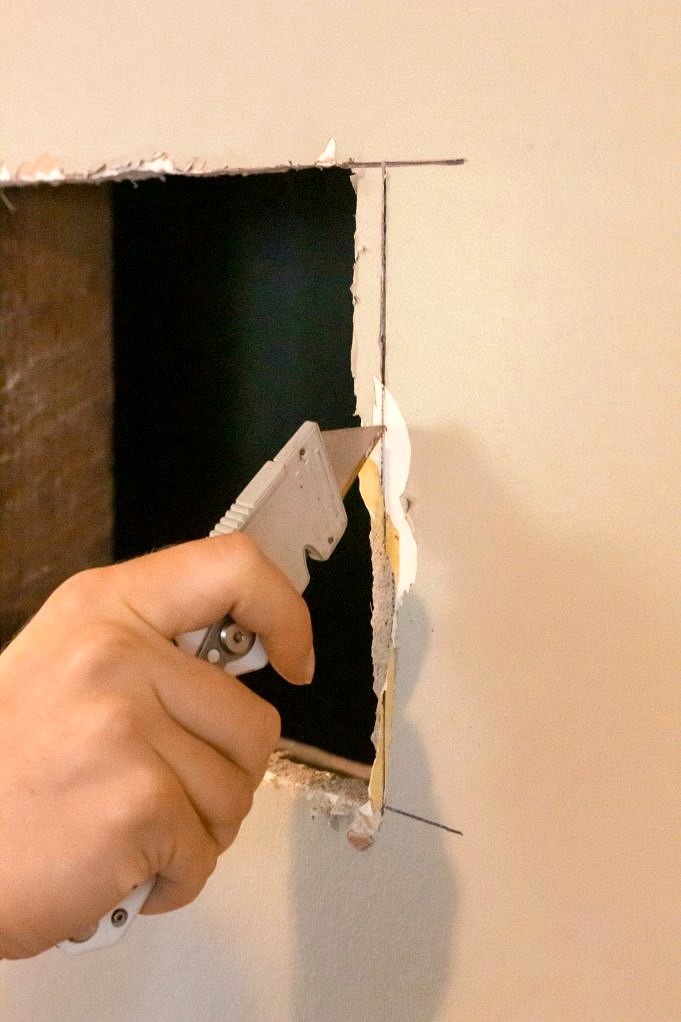Every DIYer and home craftman should be familiar with drywall. It is one of the most widely used construction materials and it is a crucial component in every room you have ever entered.
Although it is easy to cut holes in drywall, it requires precision. It is easy to see why it can be intimidating. We will show you how to make a hole in drywall.
What You’ll Need
You only need a few tools to cut drywall. This means you don’t have to buy any new tools or break out the power tools. Here’s what you will need:
- A drywall saw or utility knife
- Power drill
- Drywall screws
- Framing square
- Carpenters Pencil
Step 1: Drywall Sheets In Full
Before you begin to cut holes in the drywall for lighting fixtures or electrical fixtures, hang all the sheets of drywall that don’t need to be cut. This step is crucial to ensure accurate measurements and a quality job.
Use a power drill to drive drywall screws through drywall and into the walls. Be careful not to drive the screws too far. The screw heads should be flush with the drywall.
Each sheet of drywall should be hung except for the ones that need to be cut.
Lowes offers some great tips for getting the job done, whether you are drilling a hole in drywall already hung or patching it.
Step II: Measuring Your Hole
Once the rest of your drywall is in place, you can now use the edges of those sheets of drywall as reference points for measuring holes.
Measure the distance between the edge of the wall and the nearest edge of your fixture. Next, note this in pencil on a sheet of drywall. Next, measure from the edge to the fixture’s far edge and mark it on the drywall.
Next, measure the distance between the top of your fixture and the edge of the wall above it. Then, measure the distance from the top of the fixture to where the floor or drywall is below it.
These measurements will help you determine exactly where to cut the hole in your wall. We will now mark the exact location of the cut on the drywall.
You will need to take the drywall piece you are going to cut holes in. It should already have the measurements that you have just taken written on it.
Measure the number you got from your first measurement from the edge of the drywall. To mark this point, use a framing ruler to draw a straight line. Repeat the process for the second measurement. Once you have completed the first measurement, use a framing ruler to mark it off. Now you have the measurements for each end of your fixture.
Next, measure the top and bottom dimensions of the fixture with your tape measure. Mark them with the framingsquare. Now you should have the exact location of your fixture marked on your drywall.
Measurements are done if you’re cutting a rectangular or square hole. If you are cutting a rectangular or square hole, your measuring work is done. However, if you want to cut a circular hole you will need to draw a circle within the box that you have just marked on the wall.
This can be done with a compass or an additional electrical or lightbox. Simply center the box within the lines that you have just drawn and trace the shape. You can also use a compass to find the center of the box marked and then use that to draw your circle.
Step 3: Cut The Hole
You can now use a utility knife or drywall saw to make the hole in your drywall.
Place your drywall on top of the saw horses.
Use a drywall-saw to place the point of your drywall saw on the line you want to cut. Then, use your spare hand and tap the saw through the wall as if it were a nail. After the saw has penetrated the drywall, it is possible to begin cutting through sheetrock by moving back and forth along the lines you have drawn.
You must ensure that you are cutting exactly along the lines that have been marked. You can only leave a gap between a fixture and the wall. If you make the hole too big, it will lead to a problem when the inspector comes.
When cutting a rectangle or square, be sure to not go beyond the intersection of two lines. This can cause damage to fragile sheetrock and will result in more spackling work later.
The same rules apply if you are using a utility knife for cutting the hole. Follow your line precisely and do not cut beyond the intersection of two lines.
Begin by inserting the utility knife’s blade into the sheetrock. Follow the lines you have drawn. After you have completed the cutting, use your hammer to gently tap the middle of the hole.
Use your utility knife to remove any drywall that is still attached to your hole after you have removed it.
The Final Word
Every home crafter should learn how to cut holes in drywall. It can seem daunting at first because it requires a lot of planning and math. You’ll soon be a pro at hanging and cutting drywall if you follow the steps.



